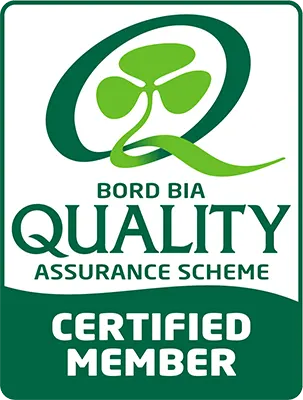Maize silage is one of the most valuable forages on Irish farms, delivering a high-quality feed that supports milk yield, fertility, and overall animal condition. Getting harvest timing right and applying best-practice clamp management are critical to preserving its feed value. Careful planning for harvest and effective clamp protection can be the difference between a silage that drives performance and one that results in costly losses.
When to Harvest Maize Silage
Your goal is to harvest maize at the ideal dry matter (DM) content capturing maximum starch while maintaining digestibility. Monitor the kernel milk line as it moves down; when it reaches two-thirds to three-quarters of the kernel, the crop is near optimal.
If frost occurs, harvest within seven days to prevent quality deterioration. Also, consider soil and weather conditions—harvesting slightly earlier may be necessary on heavy or wet ground to avoid machinery damage and soil compaction.
Avoid harvesting too early, as immature crops can cause effluent runoff rich in starch and may require additives like beet pulp or soya hulls to maintain pit stability and nutrient retention. Regular crop and field monitoring is essential for the best harvest timing, and with the good weather this season, maize is likely to come in earlier than usual — so it’s worth starting to monitor fields from the end of this month..
Fundamentals of High-Quality Maize Silage
Good maize silage starts with careful planning:
- Select the right variety based on location, soil, weather, and feeding goals.
- Harvest at correct maturity, assessing both kernel and whole plant development.
- Choose an optimal chop length balancing compaction and rumen function.
- Ensure effective kernel processing to unlock starch.
- Achieve high compaction to reduce oxygen pockets.
- Seal the clamp quickly and airtight to lock in feed quality.
Delays or poor ensiling can lead to spoilage, heating, and nutrient losses, reducing the value of your crop.
Harvest Timing & Chop Length: The Foundations of Maize Silage Quality
Harvesting at the right stage and chopping to the correct length are key to ensuring good compaction and feed quality. A chop length of 10–18mm supports effective consolidation, while slightly longer lengths can be used with kernel processing. Avoid chopping too fine, as this can impact rumen health and increase effluent risk.
Why Maize Needs Extra Protection
Maize silage requires extra care beyond other forages due to:
- Its high value and rapid loss risk: Maize is costly to grow, and any damage or spoilage quickly reduces feed value. Consider additives like Magniva Platinum Maize Elite, which protects high-value maize silage during longer feed-out periods by preventing heating and spoilage with a blend of bacteria.
- Increased bird damage risk: Maize attracts birds more than other crops, which can cause contamination and spoilage if the clamp isn’t sealed tightly.
- Exposure to environmental factors: Sunlight, rain, wind, and physical damage can degrade silage quality without adequate cover protection. For higher dry matter maize, Magniva Platinum Maize speeds fermentation, reduces dry matter loss, and improves aerobic stability.
This makes effective clamp sealing essential to preserve quality, reduce aerobic spoilage, and maintain feed energy.
How to Cover Maize Silage Right: The Specialist Nutrition Two-Layer System
Specialist Nutrition recommends a two-layer cover system proven to protect maize silage over long storage periods:
- Oxygen barrier film:
Placed directly over the silage surface, this layer prevents oxygen ingress, crucial for reducing aerobic spoilage and heating during storage. - Anti-UV cover:
The final layer protects against sunlight, weather, birds, and physical damage. High-quality anti-UV covers can last up to 10 years when handled and stored correctly.
This setup eliminates the need for traditional black polythene and tyres, making covering and uncovering quicker, safer, and more efficient.
Handling Tips for Clamp Covers
- For anti-UV covers, use smaller-sized sheets for easier handling and cleaning without additional cost per square metre.
- For anti-UV covers, proper folding and storage extend their lifespan.
- For all covers, ensure a tight, wrinkle-free seal across all layers to maximise protection and preserve silage quality.
Preparing, Filling, and Compacting the Clamp
- Clean and line pit walls with polythene to minimise oxygen ingress.
- Fill the clamp in thin layers (~15cm), compacting thoroughly after each layer.
- Use a heavy tractor to roll continuously during filling to ensure dense packing and reduce mould risk.
Quick Guide to Assessing Maize Silage Quality
| Characteristic | What to Look For in High-Quality Maize Silage |
| Odour | Fresh, pleasantly acidic aroma; no alcohol, butyric acid, yeast, mould, or strong acetic acid smells. |
| Colour | Golden-yellow or yellow-olive depending on variety; consistent colour throughout. |
| Mould | No visible mould present. |
| Structure | Plant material intact, with no microbial breakdown. |
| Contamination | Free from dirt, stones, and foreign objects. |
Compaction test: Press a thumb or a ballpoint pen into the clamp face; harder resistance means better compaction. For precision, use a silo borer to measure volume and dry matter content.
Compensating for Poor Maize Silage Quality
When silage starch or fibre levels are lower than desired, ration adjustments and additives help maintain animal performance:
- Use high-energy concentrates to balance low starch.
- Choose supplements based on rumen degradability and fibre digestibility, such as cereals for fast energy or dried beet pulp for fibre.
- Avoid fully replacing silage starch with grain maize due to its higher rumen-resistant starch.
Achieve Higher-Quality Maize Silage This Season
By following expert advice on harvest timing, silage preparation, compaction, sealing, and feed-out management, you can reduce losses, maintain nutrient quality, and improve feed efficiency. Specialist Nutrition offers tailored solutions and proven animal feed products to help you maximise the value of your maize silage crop — from the field right through to the feed trough.
Contact our team today to discuss how to optimise your maize silage harvest and clamp protection for better animal performance and profitability.





